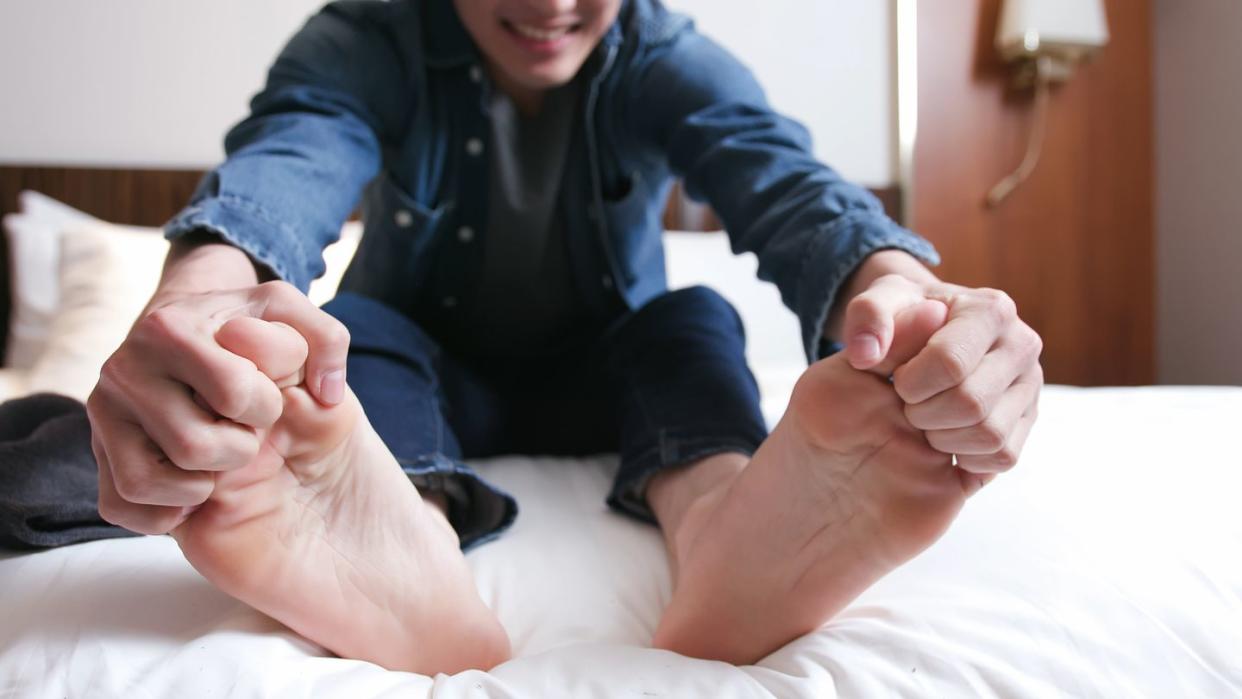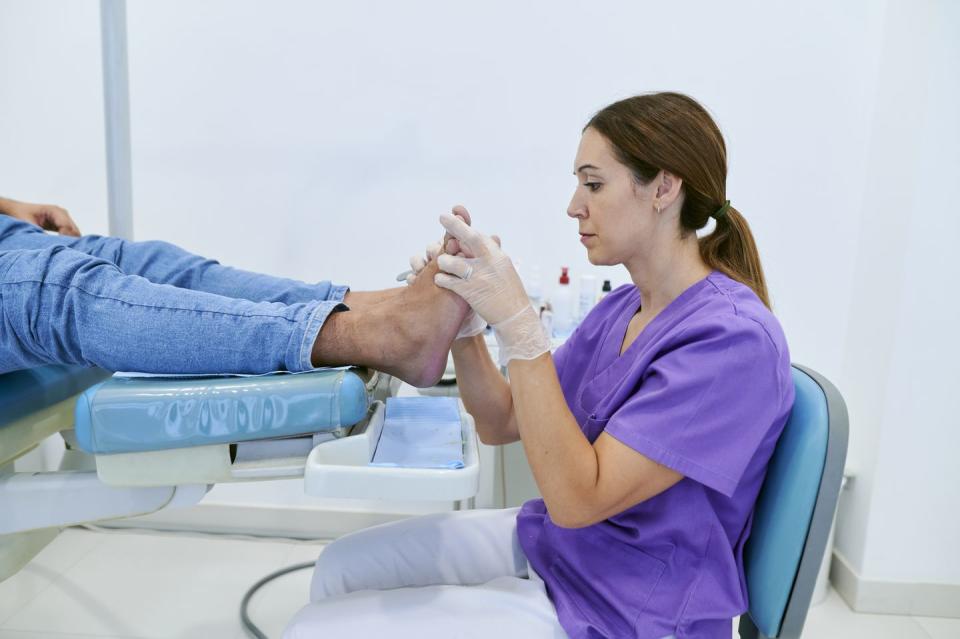Why Are My Toenails White? Doctors Explain.

"Hearst Magazines and Yahoo may earn commission or revenue on some items through these links."
FLIP-FLOP SEASON is just around the corner. If you've taken a good look at your feet without wooly socks and boots, you might be noticing chalky spots on your toenails or a complete white discoloration. This sight can be alarming, but doctors say it’s usually not much to worry about.
White toenails, technically known as leukonychia, are pretty common for men, especially as they age, says Jay Wofford, M.D., F.A.A.D., a board-certified dermatologist at U.S. Dermatology Partners North Dallas.
“The nail of the big toe is most commonly affected by leukonychia,” he says.
The condition is generally harmless and can show up as white spots or streaks on your nails or an overall white discoloration, according to the Cleveland Clinic. It can be caused by a number of factors—from nail trauma to fungus. In some instances, it can signal a more serious health condition, such as diabetes.
Dr. Wofford says he often sees leukonychia in runners and people who do high-intensity training. These workouts can sometimes cause trauma to your toenails.
Fortunately, white toenails can be treated. But it can take several months to get rid of the white marks, since toenails are slow-growing, Dr. Wofford says. The most effective treatment for white toenails depends on the cause, so it’s usually best to see a dermatologist if your white toenails are persisting.
There are also steps you can take to prevent leukonychia, he adds. Here’s everything you need to know about white toenails, including the causes, treatments, prevention tips, and when to see a doctor about them.
What are white toenails?
Leukonychia can occur on your toenails and fingernails. It can show up as partial or full discoloration of the nail or large or small white marks.
There are three types, according the Cleveland Clinic:
True leukonychia, where white spots develop where the nail starts to grow, known as the nail matrix, and show up on your nail plate, which is the hard part of your nail
Apparent leukonychia, where white spots develop in the skin in the nail bed
Pseudoleukonychia, where white spots develop on the nail’s surface
What causes white toenails?
Many factors can cause white toenails, says Lori Aliksanian, M.D., a physician and owner of MedBeautyLA. “Each cause will appear a little different.”

Nail fungus, also known as onychomycosis, is one of the most common reasons you get white toenails. Dr. Aliksanian says you could get nail fungus from walking barefoot in a locker room, from improperly sanitized pedicure stations, or from keeping your sweaty shoes and socks on for too long.
“Fungal nail infections typically occur following an initial trauma to the nail bed (giving the fungus an easier entry) and will start off looking like white scattered speckles on the nail,” she says. “This can then progress to whitish-yellow brittle toenails that can be painful and unsightly.”
When you have nail fungus, the surface of the nail may turn white and feel soft, dry, or powdery, according to the American Academy of Dermatology. Your nail might thin out, so much so that you can scrape off bits of it.
Trauma to the nail, such as from repeated pedicures, an injury, or regularly exercising, also causes white toenails. Dr. Wofford says he often sees white toenails in men who regularly run long distances, do intense exercises like CrossFit, or are avid hikers.
“It’s the repetitive type of trauma to the nail over long periods of time that most commonly causes trauma-related leukonychia,” he says.
Skin conditions, like psoriasis or eczema, might also lead to white nails, Dr. Wofford says. In rare instances, he says white toenails can be from medications like chemotherapy, zinc or iron deficiencies, a protein deficiency, or an underlying health condition, like kidney disease, liver disease, or hyperthyroidism.
Can you prevent white toenails?
Unless you want to give up your intense workouts, white toenails caused by nail trauma may not always be preventable, Dr. Wofford says. But, but there are some things you can do to help.
“Wear properly sized shoes with enough room to wiggle your toes and account for swelling post-workout,” Dr. Aliksanian says.
Also, wear breathable socks made from sweat-wicking materials like wool and change out of wet or sweaty footwear as soon as you can, she adds. Wear your own sandals in a spa or locker room and make sure the nail salons you use sanitize or dispose of their instruments after each customer.
Regularly moisturize the skin around the nail, including the cuticle, Dr. Wofford adds. “It can go a long way toward improving nail appearance.”
He also suggests avoiding nail polish and nail polish remover. They contain harsh chemicals that are harmful to the nail plate and can contribute to leukonychia.
How to Treat White Toenails
The most effective treatments for white toenails depend on the cause, Dr. Wofford says.
For trauma to the nail, avoiding what’s causing it can resolve leukonychia, he explains. You can also reduce the trauma by wearing shoes that fit well and give your toes plenty of room.
Regularly moisturizing the skin around the nail and your cuticles will help, too. Dr. Wofford recommends also trying over-the-counter products for trauma-related nail discoloration, such as Tolvere.
If you have nail fungus, the most effective treatment is a prescription medication, such as an oral or topical anti-fungal, he adds.
White toenails can take time to treat, Dr. Wofford emphasizes, “I remind my patients that any treatment or intervention will take six to nine months to yield results due to the slow nature of toenail growth.”
When to See a Doctor
It’s usually best to see a dermatologist about your white toenails, Dr. Aliksanian says. They can identify what’s causing them by testing a sample of your nail for fungus, so you can get the best treatment.
However, sometimes, doctors will prescribe an anti-fungal from just looking at the nail, without needing to do a test, Dr. Wofford says.
If you notice that multiple nails are white, it’s a good idea to see your doctor, he says. “Any type of white discoloration that has a symmetric pattern involving most or all nails should prompt medical evaluation.”
Symmetric leukonychia—or if you notice that the whiteness disappears when you press your nail down—could signal a more serious health condition, and Dr. Wofford says a more in-depth evaluation is needed to look for underlying causes.
You Might Also Like
